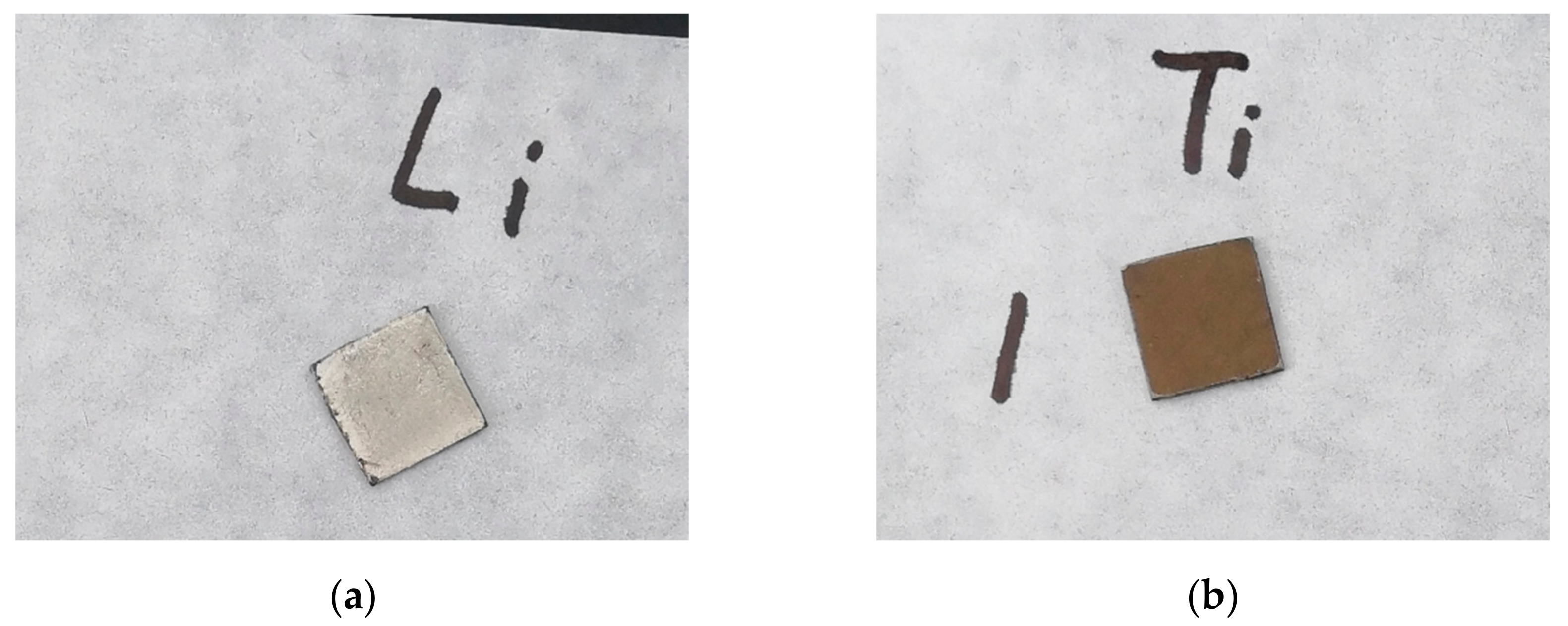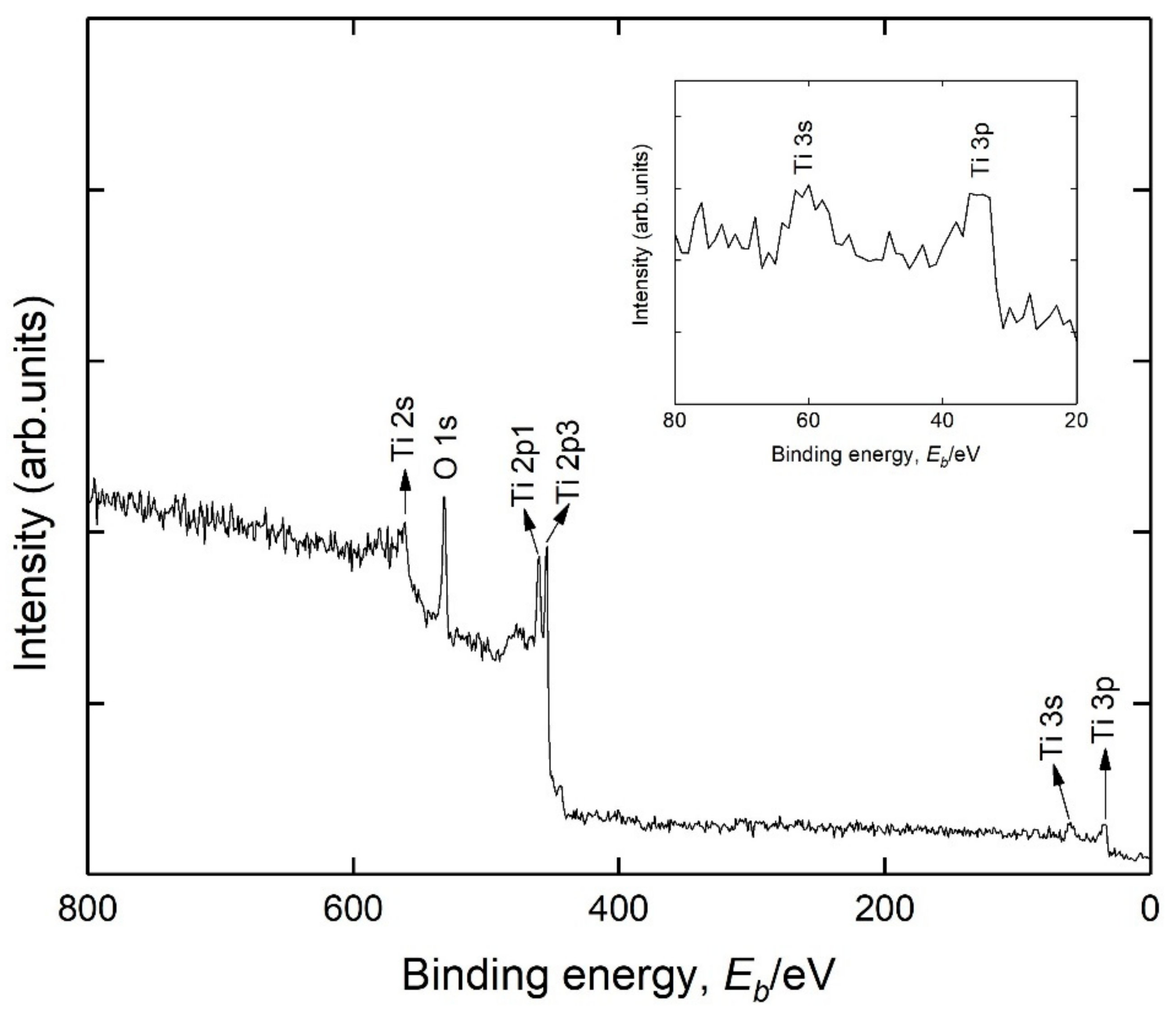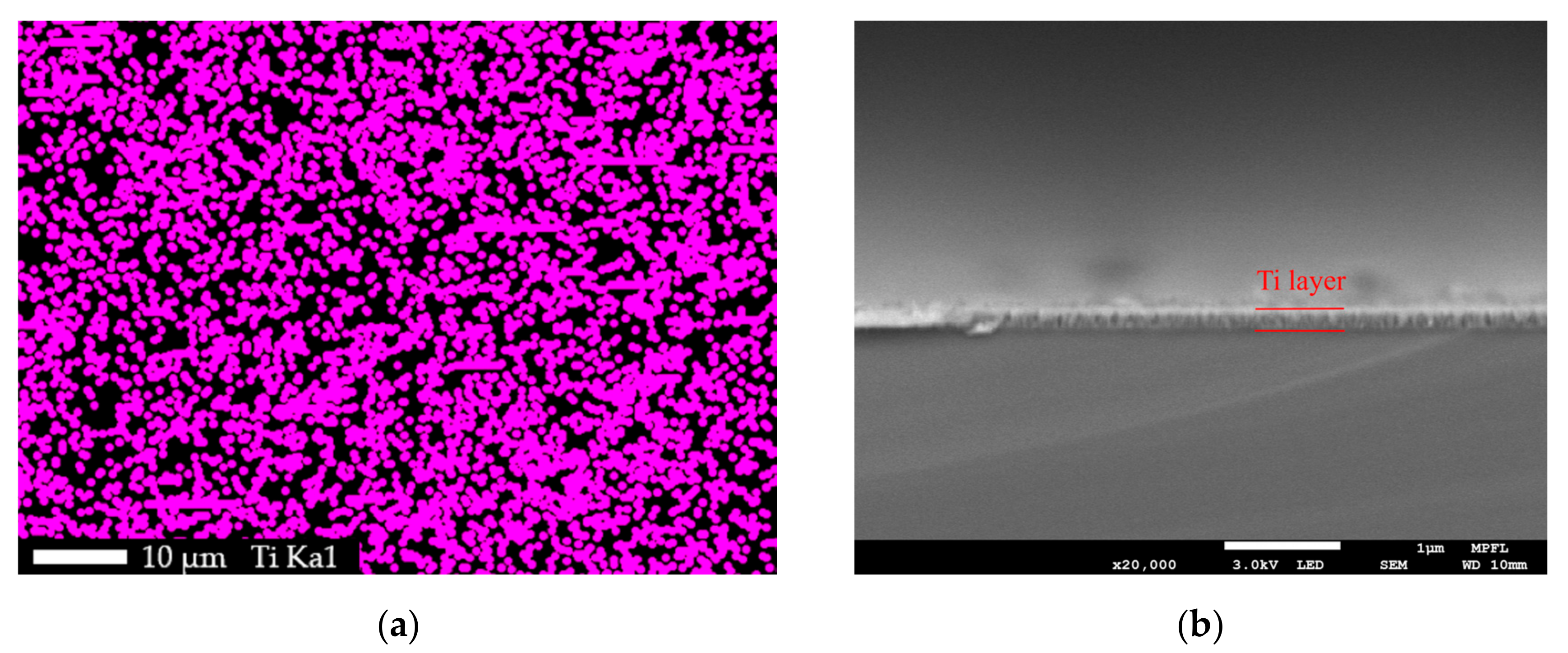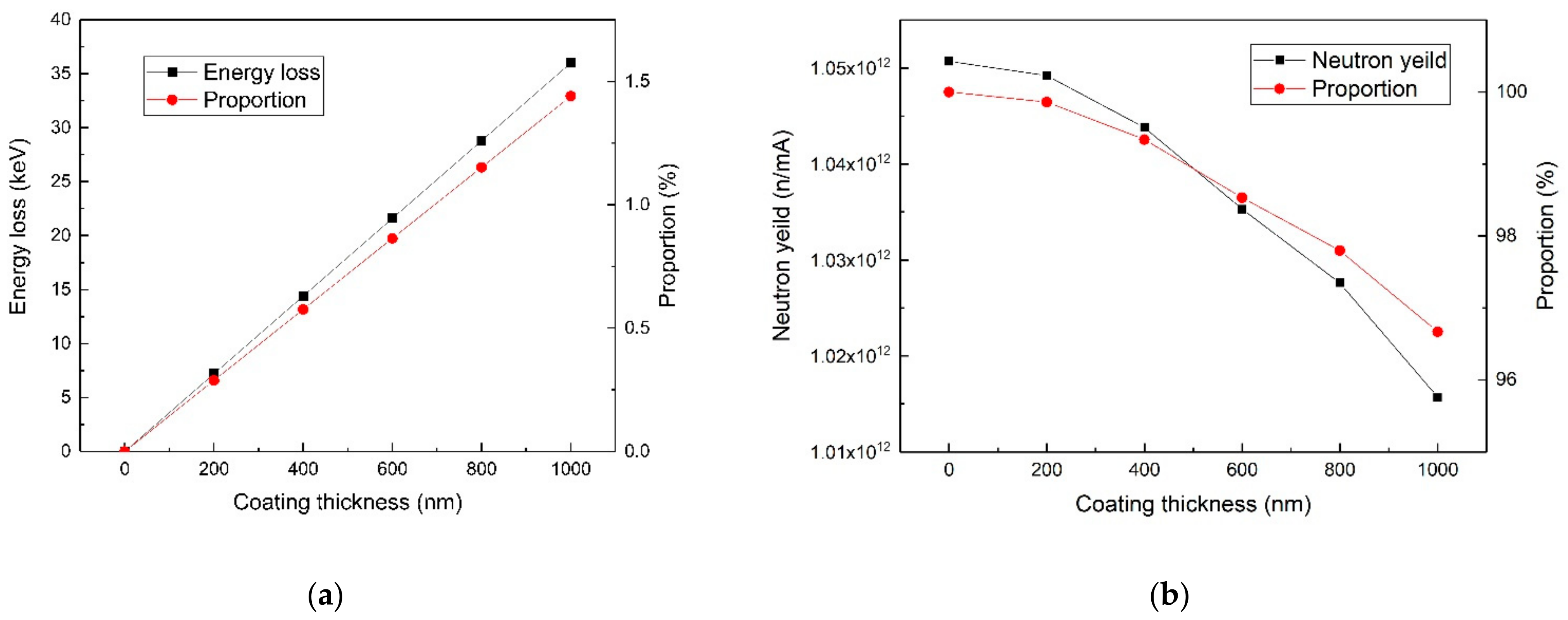Depositing a Titanium Coating on the Lithium Neutron Production Target by Magnetron Sputtering Technology
Abstract
1. Introduction
2. Materials and Methods
2.1. Samples
2.2. Magnetron Sputtering
2.3. Air Exposure Process
2.4. Characterization and Analysis
2.5. Monte Carlo Simulation
3. Results and Discussion
3.1. Samples with/without Coating in the Air
3.2. XPS Results
3.3. SEM and EDS Results
3.4. XRD Results
3.5. Monte Carlo Simulation Results
4. Conclusions
Author Contributions
Funding
Institutional Review Board Statement
Informed Consent Statement
Data Availability Statement
Conflicts of Interest
References
- Hirota, K.; Awano, S.; Fujiie, T.; Fukumura, S.; Hishida, M.; Ichikawa, G.; Imajo, S.; Itoh, I.; Iwashita, Y.; Kitaguchi, M.; et al. Design and Construction of an Imaging beamline at the Nagoya University Neutron Source. EPJ Web Conf. 2020, 231, 05002. [Google Scholar] [CrossRef][Green Version]
- Wang, S.; Zou, Y.; Wang, H.; Lu, Y.; Guo, Z. Preliminary Experiments of Coded Source Neutron Imaging on Accelerator-driven Neutron Source. Phys. Procedia 2014, 60, 341–348. [Google Scholar] [CrossRef][Green Version]
- Kamiyama, T.; Ueno, H.; Kiyanagi, Y. Improvement of Vacuum Tube Type Neutron Image Intensifier for Accelerator-Based Neutron Imaging. In Proceedings of the 2012 IEEE Nuclear Science Symposium and Medical Imaging Conference Record (NSS/MIC), Anaheim, CA, USA, 27 October–3 November 2012; pp. 167–170. [Google Scholar] [CrossRef]
- Blue, T.E.; Yanch, J.C. Accelerator-based Epithermal Neutron Sources for Boron Neutron Capture Therapy of Brain Tumors. J. Neuro Oncol. 2003, 62, 19–31. [Google Scholar] [CrossRef] [PubMed]
- Yanch, J.C.; Zhou, X.-L.; Shefer, R.E.; Klinkowstein, R.E. Accelerator-based epithermal neutron beam design for neutron capture therapy. Med. Phys. 1992, 19, 709–721. [Google Scholar] [CrossRef] [PubMed]
- Kasatov, D.; Koshkarev, A.; Kuznetsov, A.; Makarov, A.; Ostreinov, Y.; Shchudlo, I.; Sorokin, I.; Sycheva, T.; Taskaev, S.; Zaidi, L. The accelerator neutron source for boron neutron capture therapy. J. Phys. Conf. Ser. 2016, 769, 012064. [Google Scholar] [CrossRef]
- Pachuau, R.; Lalremruata, B.; Otuka, N.; Hlondo, L.R.; Punte, L.R.M.; Thanga, H.H. Thick and Thin Target7Li(p,n)7Be Neutron Spectra Below the Three-Body Breakup Reaction Threshold. Nucl. Sci. Eng. 2017, 187, 70–80. [Google Scholar] [CrossRef]
- Lee, C.L.; Zhou, X.-L. An algorithm for computing thick target differential p-Li neutron yields near threshold. In AIP Conference Proceedings; AIP: College Park, MD, USA, 1999; Volume 227, pp. 227–230. [Google Scholar] [CrossRef]
- Lee, C.L.; Zhou, X.L. Thick target neutron yields for the 7Li(p,n)7Be reaction near threshold. Nucl. Instrum. Methods Phys. Res. Sect. B 1999, 152, 1–11. [Google Scholar] [CrossRef]
- Kamienski, C.W.; Mcdonald, D.P.; Stark, M.W.; Papcun, J.R. Lithium and Lithium Compounds, Kirk-Othmer Encyclopedia of Chemical Technology. Am. Cancer Soc. 2004. [Google Scholar] [CrossRef]
- Bayanov, B.; Belov, V.; Kindyuk, V.; Oparin, E.; Taskaev, S. Lithium neutron producing target for BINP accelerator-based neutron source. Appl. Radiat. Isot. 2004, 61, 817–821. [Google Scholar] [CrossRef] [PubMed]
- Ishiyama, S.; Baba, Y.; Fujii, R.; Nakamura, M.; Imahori, Y. In-situ vacuum deposition technique of lithium on neutron production target for BNCT. Nucl. Instrum. Methods Phys. Res. Sect. B 2012, 288, 18–22. [Google Scholar] [CrossRef]
- Matysiak, W.; Prestwich, W.; Byun, S. Precise measurements of the thick target neutron yields of the 7Li(p,n) reaction. Nucl. Instrum. Methods Phys. Res. Sect. A 2011, 643, 47–52. [Google Scholar] [CrossRef]
- Zhou, X.-L.; Lee, C. Lithium compounds as targets for (p,n) reactions. Appl. Radiat. Isot. 1997, 48, 1493–1496. [Google Scholar] [CrossRef]
- Ishiyama, S.; Baba, Y.; Fujii, R.; Nakamura, M.; Imahori, Y. Thermal Stability of BNCT Neutron Production Target Synthesized by In-Situ Lithium Deposition and Ion Implantation. J. Jpn. Inst. Met. 2013, 77, 509–513. [Google Scholar] [CrossRef]
- Ishiyama, S.; Baba, Y.; Fujii, R.; Nakamura, M.; Imahori, Y. Direct Synthesis of Li3N Thin Layer on Lithium Target Surface for BNCT in N2 Gaseous Conditions. Mater. Trans. 2013, 54, 1765–1769. [Google Scholar] [CrossRef]
- Yoshioka, M. Review of Accelerator-Based Boron Neutron Capture Therapy machines. In Proceedings of the IPAC2016, Busan, Korea, 8–13 May 2016; pp. 5–9. [Google Scholar]
- Honda, S.; Yoshihashi, S.; Tsuchida, K.; Kiyanagi, Y.; Tsurita, Y.; Watanabe, K.; Yamazaki, A.; Tsuzi, Y.; Tsuneyoshi, T.; Uritani, A. Development of a Sealed Lithium Target for BNCT in Nagoya University. In Proceedings of the 10th Young Researchers BNCT Meeting, Helsinki, Finland, 26–29 September 2019. [Google Scholar]
- Frey, H.; Khan, H.R. Handbook of Thin-Film Technology; McGraw-Hill: New York, NY, USA, 2015. [Google Scholar] [CrossRef]
- Henini, M. Handbook of Thin-Film Deposition Processes and Techniques. Microelectron. J. 2000, 31, 219. [Google Scholar] [CrossRef]
- Musil, J. Recent advances in magnetron sputtering technology. Surf. Coatings Technol. 1998, 100–101, 280–286. [Google Scholar] [CrossRef]
- Tan, X.-Q.; Liu, J.-Y.; Niu, J.-R.; Liu, J.-Y.; Tian, J.-Y. Recent Progress in Magnetron Sputtering Technology Used on Fabrics. Materials 2018, 11, 1953. [Google Scholar] [CrossRef] [PubMed]
- Bolser, D.R. Aluminum Coating for the Corrosion Protection of Welds. US Patent 7,066,375, 27 June 2006. [Google Scholar]
- Lin, N.; Xie, F.; Zhou, J.; Wu, X.; Tian, W. Corrosion behaviors of P110 steel and chromium coating in CO2-saturated simulated oilfield brine. J. Wuhan Univ. Technol. Sci. Ed. 2011, 26, 190–196. [Google Scholar] [CrossRef]
- Jeyachandran, Y.; Karunagaran, B.; Narayandass, S.; Mangalaraj, D.; Jenkins, T.; Martin, P. Properties of titanium thin films deposited by dc magnetron sputtering. Mater. Sci. Eng. A 2006, 431, 277–284. [Google Scholar] [CrossRef]
- Jin, Y.; Liu, D.; Chen, J.; Wu, W. Effect of Magnetron Sputtering Process on Forming of Ti Thin Film. J. Sichuan Univ. Sci. Eng. 2006, 19, 49–51. [Google Scholar] [CrossRef]
- Zhang, E.; Xu, L.; Yang, K. Formation by ion plating of Ti-coating on pure Mg for biomedical applications. Scr. Mater. 2005, 53, 523–527. [Google Scholar] [CrossRef]
- El Kadiri, H.; Wang, L.; Gülsoy, H.O.; Suri, P.; Park, S.J.; Hammi, Y.; German, R.M. Development of a Ti-based alloy: Design and experiment. JOM 2009, 61, 60–66. [Google Scholar] [CrossRef]
- Bracken, J.D. The History and Use of Our Earth’s Chemical Elements: A Reference Guide (Krebs, Robert E.). J. Chem. Educ. 1999, 76, 76. [Google Scholar] [CrossRef]
- Ziegler, J.F.; Ziegler, M.; Biersack, J. SRIM—The stopping and range of ions in matter (2010). Nucl. Instrum. Methods Phys. Res. Sect. B 2010, 268, 1818–1823. [Google Scholar] [CrossRef]
- Werner, C.J.; Bull, J.S.; Solomon, C.J.; Brown, F.B.; McKinney, G.W.; Rising, M.E.; Dixon, D.A.; Martz, R.L.; Hughes, H.G.; Cox, L.J.; et al. MCNP Version 6.2 Release Notes. Los Alamos National Laboratory: Santa Fe, NM, USA, 2018. [Google Scholar]
- Lee, C.L.; Zhou, X.-L.; Kudchadker, R.J.; Harmon, F.; Harker, Y.D. A Monte Carlo dosimetry-based evaluation of the 7Li(p,n)7Be reaction near threshold for accelerator boron neutron capture therapy. Med. Phys. 2000, 27, 192–202. [Google Scholar] [CrossRef] [PubMed]
- Tanaka, S.; Taniguchi, M.; Tanigawa, H. XPS and UPS studies on electronic structure of Li2O. J. Nucl. Mater. 2000, 283, 1405–1408. [Google Scholar] [CrossRef]
- Vickerman, J.C. Surface Analysis—The Principal Techniques. Anal. Proc. 2009, 9, 476–486. [Google Scholar]
- Seah, M.P.; Dench, W.A. Quantitative electron spectroscopy of surfaces: A standard data base for electron inelastic mean free paths in solids. Surf. Interface Anal. 1979, 1, 2–11. [Google Scholar] [CrossRef]
- Vieira, R.D.A.; Nono, M.D.C.D.A. Nucleation and growth microstructural study of ti films on 304 SS substrates. Mater. Res. 2004, 7, 479–482. [Google Scholar] [CrossRef]
- Yang, J. The Research of Titanium Film Deposited on Steel Surface by Magnetron Sputtering. Master’s Thesis, Xihua University, Chengdu, China, 2010. [Google Scholar]







| Number | Substrate Components | Coating | Treatment | Characterization |
|---|---|---|---|---|
| (1) | Li/Ta | - | Exposure | Observation; SEM; XRD |
| (2) | Li/Ta | Ti | Exposure; Scratch | Observation |
| (3) | Li/Ta | Ti | Exposure | XRD |
| (4) | Li/Ta | Ti | - | XPS |
| (5) | Li/Ta | Ti | Exposure | SEM; EDS |
| (6) | Si | Ti | Section | SEM; XRD |
Publisher’s Note: MDPI stays neutral with regard to jurisdictional claims in published maps and institutional affiliations. |
© 2021 by the authors. Licensee MDPI, Basel, Switzerland. This article is an open access article distributed under the terms and conditions of the Creative Commons Attribution (CC BY) license (https://creativecommons.org/licenses/by/4.0/).
Share and Cite
Qiao, Z.; Li, X.; Lv, Y.; Xie, Y.; Hu, Y.; Wang, J.; Li, H.; Wang, S. Depositing a Titanium Coating on the Lithium Neutron Production Target by Magnetron Sputtering Technology. Materials 2021, 14, 1873. https://doi.org/10.3390/ma14081873
Qiao Z, Li X, Lv Y, Xie Y, Hu Y, Wang J, Li H, Wang S. Depositing a Titanium Coating on the Lithium Neutron Production Target by Magnetron Sputtering Technology. Materials. 2021; 14(8):1873. https://doi.org/10.3390/ma14081873
Chicago/Turabian StyleQiao, Zhaopeng, Xiaobo Li, Yongsheng Lv, Yupeng Xie, Yaocheng Hu, Jie Wang, Haipeng Li, and Sheng Wang. 2021. "Depositing a Titanium Coating on the Lithium Neutron Production Target by Magnetron Sputtering Technology" Materials 14, no. 8: 1873. https://doi.org/10.3390/ma14081873
APA StyleQiao, Z., Li, X., Lv, Y., Xie, Y., Hu, Y., Wang, J., Li, H., & Wang, S. (2021). Depositing a Titanium Coating on the Lithium Neutron Production Target by Magnetron Sputtering Technology. Materials, 14(8), 1873. https://doi.org/10.3390/ma14081873






